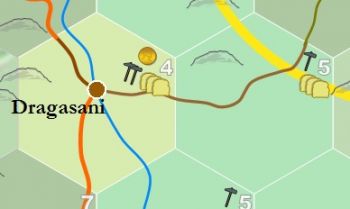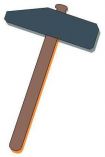Hammer (symbol)
-
 6-mile map of the village Dragasani and surrounding area, showing two hammers in a type-4 hex and one hammer in a type-5.
6-mile map of the village Dragasani and surrounding area, showing two hammers in a type-4 hex and one hammer in a type-5.
Hammers are symbols used on game maps to represent the number of accumulated facilities that a given civilised hex has constructed and presently maintains. The number of hammers possessed by a hex is determined by the hex type, which in turn is a product of infrastructure. Hex types range from 1 to 8, with a "1" indicating a highly civilised hex and an "8" indicating uncivilised wilderness. Thus, type-1 and type-2 hexes possess many hammers, while type-7 and type-8 hexes may have none at all.
Contents
| Hex Type % |
Hammers Gained | |
|---|---|---|
| Arable | Non-Arable | |
| 7 | 0 | 2 |
| 6 | 1 | 2 |
| 5 | 1 | 3 |
| 4 | 2 | - |
| 3 | 3 | - |
| 2 | 4 | - |
| 1 | 4 | - |
Number of Hammers
Maps in which hammers appear have hexes that possess two designations: arable and non-arable. Arable hexes are primarily farm and pasture land. Non-arable hexes are those exploited for the sake of mining or quarrying. Type-1 to type-4 hexes are always designated as arable; type-5 to type-7 hexes may be arable or non-arable; and type-8 hexes are always treated as non-arable, though some may have the potential to be made arable. Since type-8 hexes don't gain hammers under any circumstances, they are not included on the table shown.
In addition to the hammers added by type, an additional +1 hammer is awarded if the hex includes a sufficiently sized river. A +1 hammer is also given for each settlement a hex includes. This means a type-7 hex might have one hammer, gained from a river, apparently making it equal to a type-6 hex. However, one hammer as it appears in a type-6 hex possesses a superior allotment of facilities by virtue of it being a more civilised hex.
Therefore, it's best not to think of "one hammer" as an isolated quantity. Each hex type may have different number of hammer, depending on its location and inclusion of a settlement. An assignment of "1" hammer may occur in three different hex types. Therefore, the number of hammers AND the hex type must be noted in allotting which facilities the hex includes.
